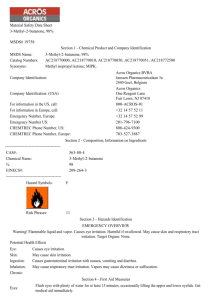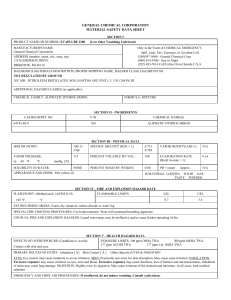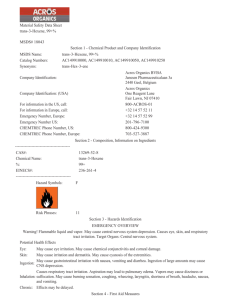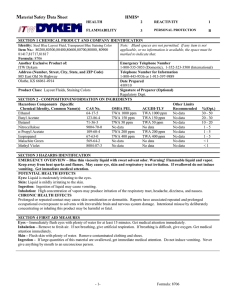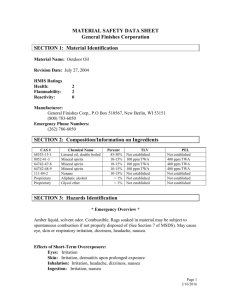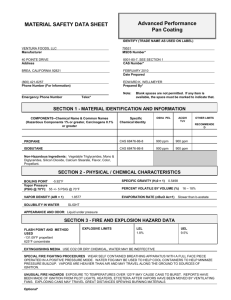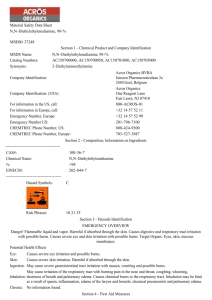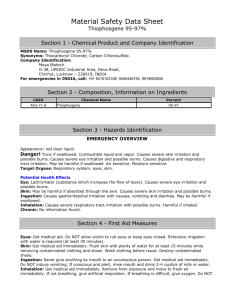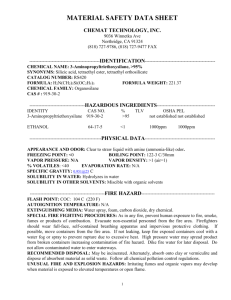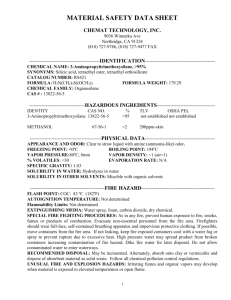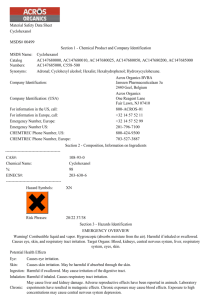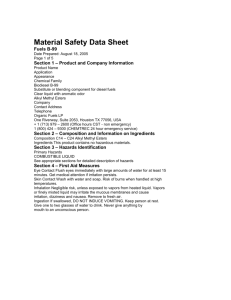Material Safety Data Sheet 2-Methylcyclohexanone, 98% MSDS
advertisement
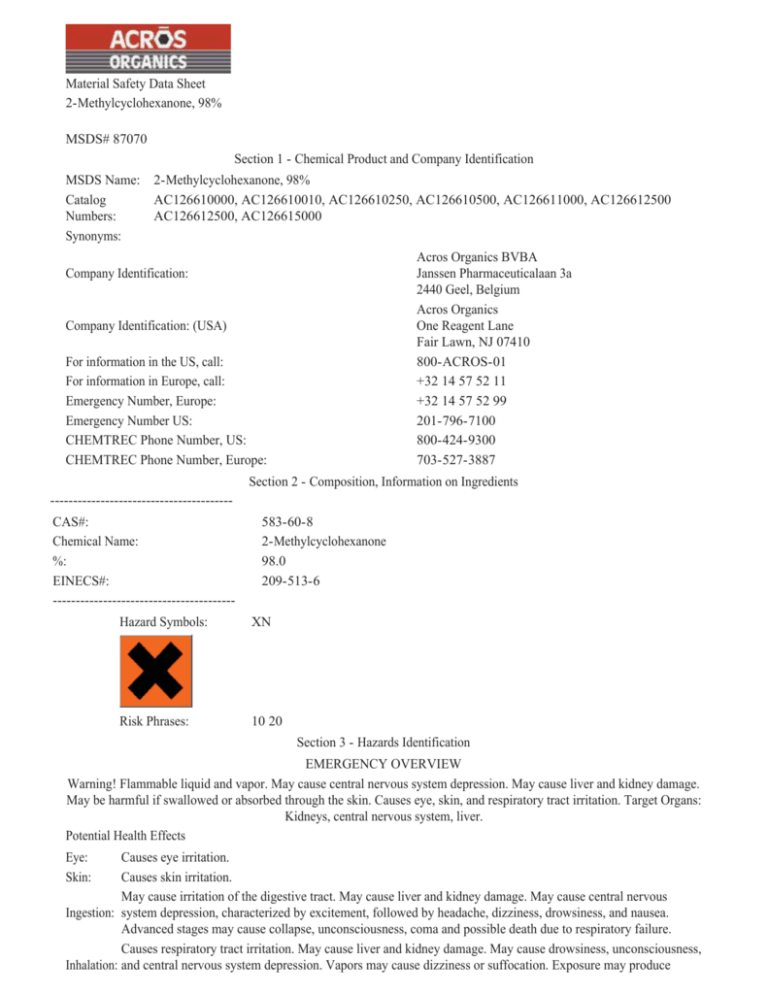
Material Safety Data Sheet 2-Methylcyclohexanone, 98% MSDS# 87070 Section 1 - Chemical Product and Company Identification MSDS Name: 2-Methylcyclohexanone, 98% Catalog AC126610000, AC126610010, AC126610250, AC126610500, AC126611000, AC126612500 Numbers: AC126612500, AC126615000 Synonyms: Acros Organics BVBA Janssen Pharmaceuticalaan 3a 2440 Geel, Belgium Acros Organics One Reagent Lane Fair Lawn, NJ 07410 800-ACROS-01 +32 14 57 52 11 +32 14 57 52 99 201-796-7100 800-424-9300 703-527-3887 Company Identification: Company Identification: (USA) For information in the US, call: For information in Europe, call: Emergency Number, Europe: Emergency Number US: CHEMTREC Phone Number, US: CHEMTREC Phone Number, Europe: Section 2 - Composition, Information on Ingredients ---------------------------------------CAS#: Chemical Name: %: EINECS#: ---------------------------------------- 583-60-8 2-Methylcyclohexanone 98.0 209-513-6 Hazard Symbols: XN Risk Phrases: 10 20 Section 3 - Hazards Identification EMERGENCY OVERVIEW Warning! Flammable liquid and vapor. May cause central nervous system depression. May cause liver and kidney damage. May be harmful if swallowed or absorbed through the skin. Causes eye, skin, and respiratory tract irritation. Target Organs: Kidneys, central nervous system, liver. Potential Health Effects Eye: Skin: Causes eye irritation. Causes skin irritation. May cause irritation of the digestive tract. May cause liver and kidney damage. May cause central nervous Ingestion: system depression, characterized by excitement, followed by headache, dizziness, drowsiness, and nausea. Advanced stages may cause collapse, unconsciousness, coma and possible death due to respiratory failure. Causes respiratory tract irritation. May cause liver and kidney damage. May cause drowsiness, unconsciousness, Inhalation: and central nervous system depression. Vapors may cause dizziness or suffocation. Exposure may produce conjunctival irritation, tearing, salivation, and lethargy. Chronic: No information found. Section 4 - First Aid Measures Eyes: Skin: Ingestion: Inhalation: Flush eyes with plenty of water for at least 15 minutes, occasionally lifting the upper and lower eyelids. Get medical aid immediately. Get medical aid. Flush skin with plenty of water for at least 15 minutes while removing contaminated clothing and shoes. If victim is conscious and alert, give 2-4 cupfuls of milk or water. Never give anything by mouth to an unconscious person. Get medical aid immediately. Remove from exposure and move to fresh air immediately. If not breathing, give artificial respiration. If breathing is difficult, give oxygen. Get medical aid. Notes to Physician: Section 5 - Fire Fighting Measures General Information: Extinguishing Media: As in any fire, wear a self-contained breathing apparatus in pressure-demand, MSHA/NIOSH (approved or equivalent), and full protective gear. Vapors may form an explosive mixture with air. Vapors can travel to a source of ignition and flash back. Use water spray to keep fire-exposed containers cool. Containers may explode in the heat of a fire. Flammable liquid and vapor. Vapors may be heavier than air. They can spread along the ground and collect in low or confined areas. May be ignited by heat, sparks, and flame. Vapors may form an explosive mixture with air. Containers may explode when heated. For small fires, use dry chemical, carbon dioxide, water spray or alcohol-resistant foam. For large fires, use water spray, fog, or alcohol-resistant foam. Use water spray to cool fire-exposed containers. Water may be ineffective. Use agent most appropriate to extinguish fire. Do NOT use straight streams of water. Autoignition Not available Temperature: Flash Point: 47.8 deg C ( 118.04 deg F) Explosion 1.20 vol % Limits: Lower: Explosion .00 vol % Limits: Upper: NFPA Rating: NFPA Rating: Section 6 - Accidental Release Measures General Information: Use proper personal protective equipment as indicated in Section 8. Spills/Leaks: Absorb spill with inert material (e.g. vermiculite, sand or earth), then place in suitable container. Remove all sources of ignition. Provide ventilation. A vapor suppressing foam may be used to reduce vapors. Water spray may reduce vapor but may not prevent ignition in closed spaces. Section 7 - Handling and Storage Wash thoroughly after handling. Use with adequate ventilation. Ground and bond containers when transferring material. Avoid contact with eyes, skin, and clothing. Empty containers retain product residue, (liquid and/or Handling: vapor), and can be dangerous. Keep container tightly closed. Keep away from heat, sparks and flame. Avoid ingestion and inhalation. Do not pressurize, cut, weld, braze, solder, drill, grind, or expose empty containers to heat, sparks or open flames. Keep away from heat, sparks, and flame. Keep away from sources of ignition. Store in a tightly closed container. Storage: Store in a cool, dry, well-ventilated area away from incompatible substances. Section 8 - Exposure Controls, Personal Protection +-------------------- +------------------- +------------------- +----------------- + | Chemical Name | ACGIH | NIOSH |OSHA - Final PELs| |-------------------- |------------------- |------------------- |----------------- | | 2-Methylcyclohexano|50 ppm; 75 ppm |50 ppm TWA; 230 |100 ppm TWA; 460 | | ne | STEL; Skin |mg/m3 TWA 600 |mg/m3 TWA | | |potential | ppm IDLH | | | |significant | | | | |contribution to | | | | |overall exposure | | | | | by the cutaneous | | | | |r oute | | | +-------------------- +------------------- +------------------- +----------------- + OSHA Vacated PELs: 2-Methylcyclohexanone: 50 ppm TWA; 230 mg/m3 TWA Engineering Controls: Use adequate general or local exhaust ventilation to keep airborne concentrations below the permissible exposure limits. Exposure Limits Personal Protective Equipment Wear appropriate protective eyeglasses or chemical safety goggles as described by OSHA's eye and face Eyes: protection regulations in 29 CFR 1910.133 or European Standard EN166. Skin: Wear appropriate protective gloves to prevent skin exposure. Clothing: Wear appropriate protective clothing to prevent skin exposure. Follow the OSHA respirator regulations found in 29 CFR 1910.134 or European Standard EN 149. Use a Respirators: NIOSH/MSHA or European Standard EN 149 approved respirator if exposure limits are exceeded or if irritation or other symptoms are experienced. Section 9 - Physical and Chemical Properties Physical State: Liquid Color: very slightly yellow Odor: acetone-like pH: Not available Vapor Pressure: 3.3 mbar @ 20 deg C Vapor Density: 3.86 Evaporation Rate: Not available Viscosity: Not available Boiling Point: 165.1 deg C ( 329.18°F) Freezing/Melting Point: -14.00 - 0.00 deg C Decomposition Temperature: Not available Solubility in water: Insoluble Specific Gravity/Density: .9240g/cm3 Molecular Formula: C7H12O Molecular Weight: 112.17 Section 10 - Stability and Reactivity Chemical Stability: Conditions to Avoid: Incompatibilities with Other Materials Hazardous Decomposition Products Hazardous Polymerization Stable under normal temperatures and pressures. Incompatible materials, ignition sources, excess heat, strong oxidants. Not available Carbon monoxide, carbon monoxide, carbon dioxide. Has not been reported. Section 11 - Toxicological Information RTECS#: CAS# 583-60-8: GW1750000 RTECS: CAS# 583-60-8: Oral, rat: LD50 = 2140 uL/kg; LD50/LC50: Skin, rabbit: LD50 = 1770 uL/kg; . Carcinogenicity: 2-Methylcyclohexanone - Not listed as a carcinogen by ACGIH, IARC, NTP, or CA Prop 65. Other: See actual entry in RTECS for complete information. Section 12 - Ecological Information Not available Section 13 - Disposal Considerations Dispose of in a manner consistent with federal, state, and local regulations. Section 14 - Transport Information US DOT Shipping Name: METHYLCYCLOHEXANONE Hazard Class: 3 UN Number: UN2297 Packing Group: III Canada TDG Shipping Name: Not available Hazard Class: UN Number: Packing Group: Section 15 - Regulatory Information European/International Regulations European Labeling in Accordance with EC Directives Hazard Symbols: XN Risk Phrases: R 10 Flammable. R 20 Harmful by inhalation. Safety Phrases: S 9 Keep container in a well-ventilated place. S 16 Keep away from sources of ignition - No smoking. S 25 Avoid contact with eyes. S 33 Take precautionary measures against static discharges. WGK (Water Danger/Protection) CAS# 583-60-8: 1 Canada CAS# 583-60-8 is listed on Canada's DSL List Canadian WHMIS Classifications: Not available This product has been classified in accordance with the hazard criteria of the Controlled Products Regulations and the MSDS contains all of the information required by those regulations. CAS# 583-60-8 is listed on Canada's Ingredient Disclosure List US Federal TSCA CAS# 583-60-8 is listed on the TSCA Inventory. Section 16 - Other Information MSDS Creation Date: 4/27/1998 Revision #6 Date 7/20/2009 The information above is believed to be accurate and represents the best information currently available to us. However, we make no warranty of merchantibility or any other warranty, express or implied, with respect to such information, and we assume no liability resulting from its use. Users should make their own investigations to determine the suitability of the information for their particular purposes. In no event shall the company be liable for any claims, losses, or damages of any third party or for lost profits or any special, indirect, incidental, consequential, or exemplary damages howsoever arising, even if the company has been advised of the possibility of such damages. --------------------------------------------------------------------------------
